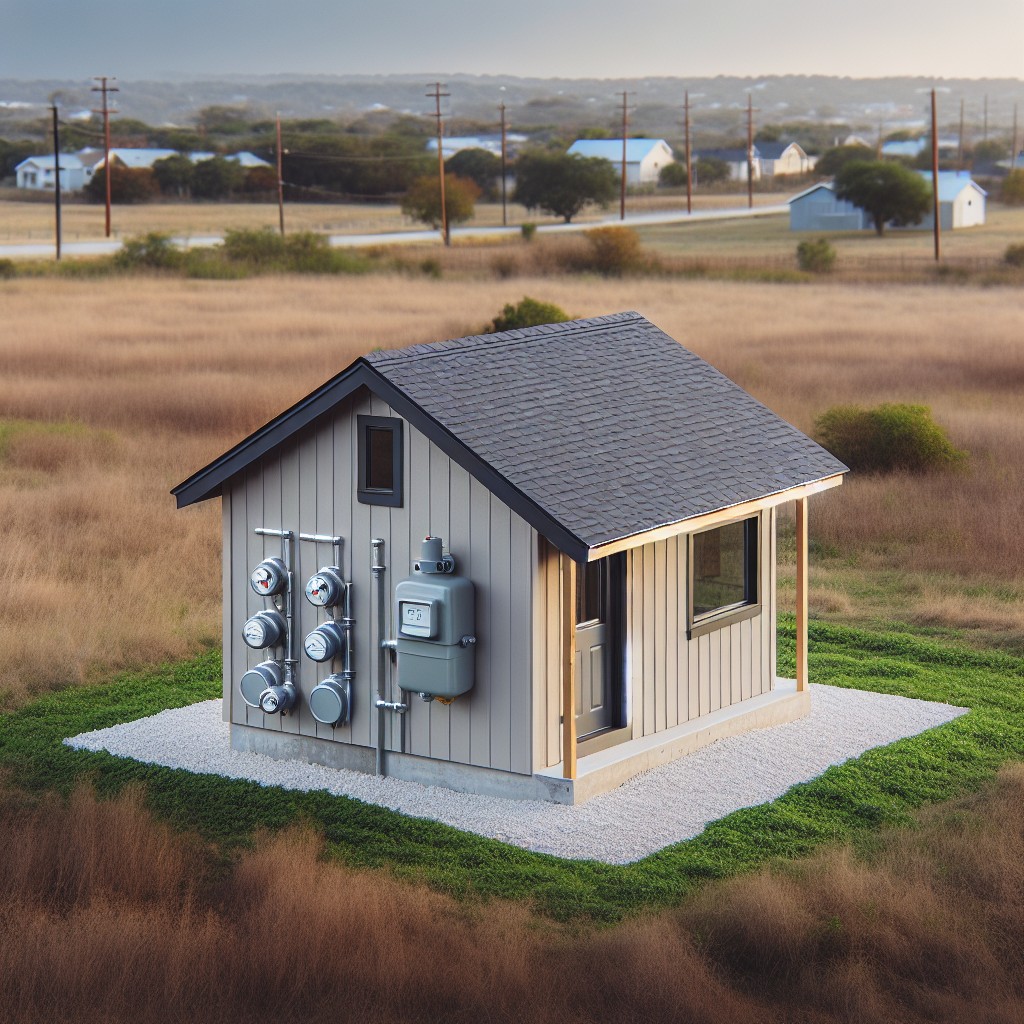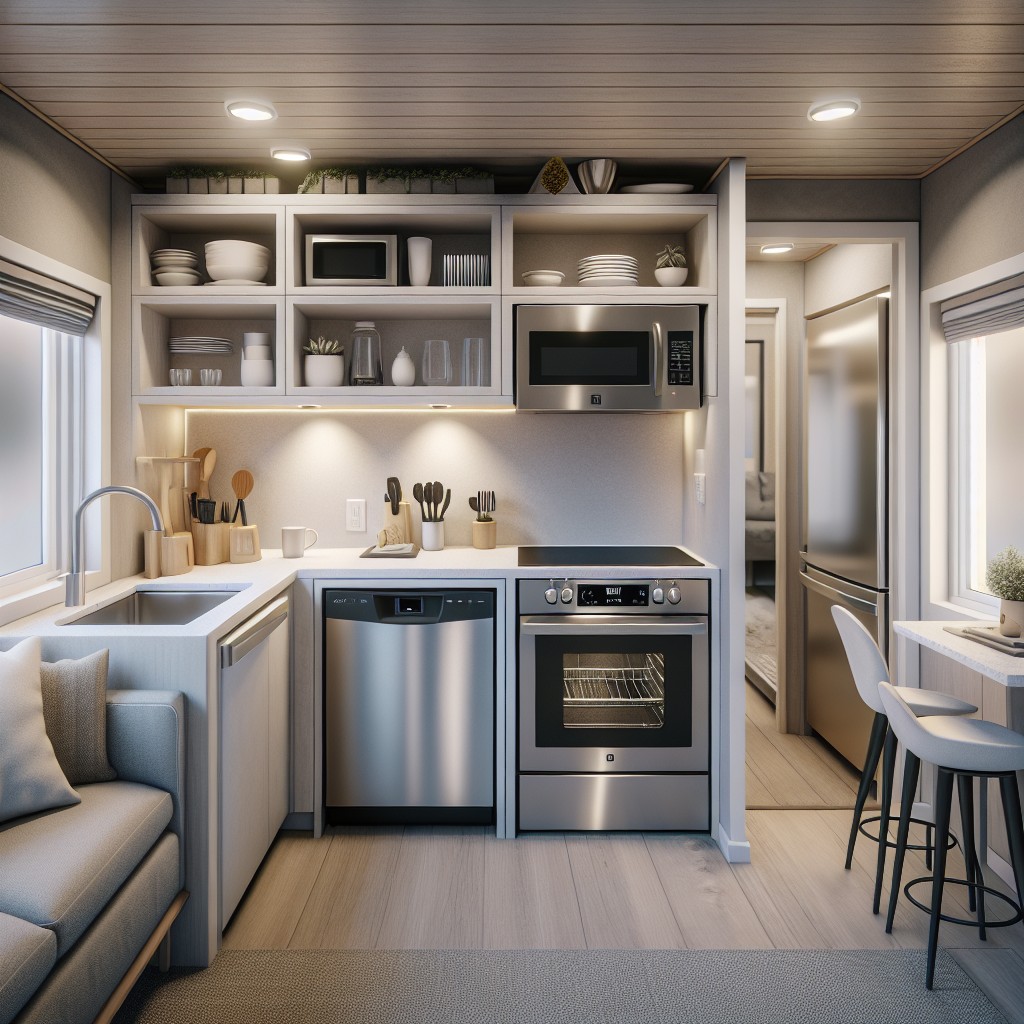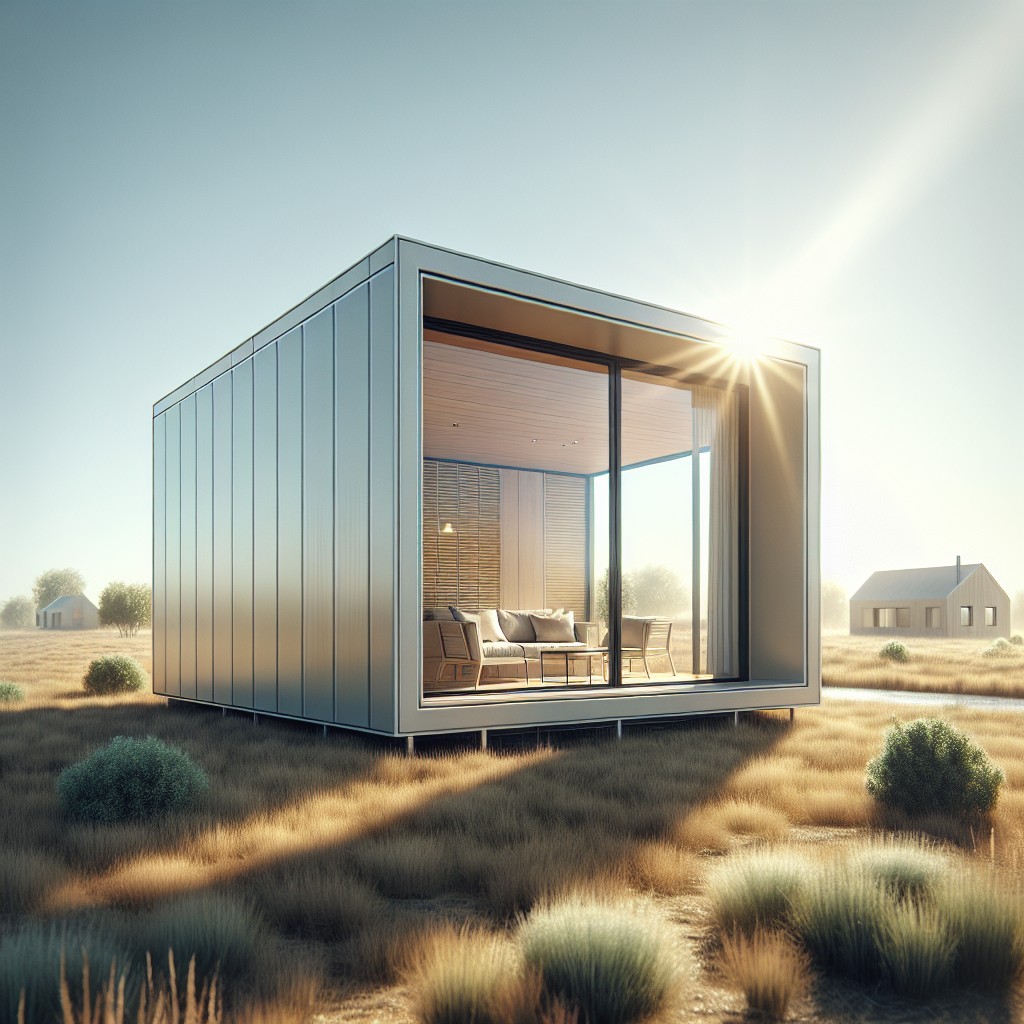Last updated on
An accessory dwelling unit (ADU) accesses utilities by utilizing the existing service connections of the primary residence, or if necessary, through separate connections set up for the unit.
An Accessory Dwelling Unit (ADU) can access utilities through connections made to the existing utilities of the main property. These connections include water, electric, gas, and sewer lines, which are extended from the main house to serve the ADU. Although independent utility connections can sometimes be made, tying utilities with the main property is the widely adopted practice due to its cost-effectiveness and logistical simplicity.
Regardless of the method, all connections must comply with local codes and regulations. Keep reading to find comprehensive details on each type of utility connection and the various regulations associated with them.
Key takeaways:
- ADUs can access utilities through existing connections or separate ones.
- Water connections may involve tapping into the main house’s supply.
- Separate water metering is possible but subject to local regulations and costs.
- Sewer connections usually tie into the primary residence’s sewer line.
- Gas connections can extend from the main house or have separate service.
WATER: Understanding Water Connection Requirements for ADUs

When adding an Accessory Dwelling Unit (ADU) to your property, ensuring proper water connection is vital. Typically, an ADU can tap into the main house’s water service line. This allows the ADU to share the water supply without the need for a new, separate service from the street, minimizing disruption and expenses.
However, some homeowners prefer the option of metering water usage separately for the ADU. Separate metering is useful for rental situations as it allows for individualized billing based on actual usage. This requires installation of an additional water meter, which may be subject to local regulations and additional costs.
In certain instances, especially in older homes or when local codes stipulate, the water lateral—being the pipe that connects the house to the municipal water main—may need upgrading to accommodate the increased water demand from the ADU. Local water authorities will guide on whether a larger diameter pipe is necessary, factoring in flow rate and pressure requirements.
Costs for water connections can vary widely based on regional labor rates, materials needed, and the complexity of the installation. It’s advisable to obtain multiple quotes and to check for potential rebates or incentives offered by local utilities or government agencies aimed at encouraging ADU development.
How Is an ADU Connected to Water Service?
To connect an ADU to water service, the homeowner typically taps into the existing water line from the primary residence. This shared connection maintains a streamlined service infrastructure and can be more cost-effective. It is essential to ensure that the existing water line and connection can handle the additional demand from the ADU. If upgrades are needed, they should meet the municipality’s standards for pipe size and pressure requirements.
In cases where homeowners prefer separate billing, a secondary water meter may be installed for the ADU. This allows for independent tracking of water usage and can be beneficial for rental situations. However, installation of a new meter involves additional costs and complying with local regulations for backflow prevention and inspection.
It’s important to engage with local utility providers early in the planning process to obtain specific requirements and determine if additional fees or charges will apply. This initial communication will guide the installation process, ensuring legal compliance and proper water service functionality for the ADU.
Can My Water for the ADU Be Metered Separately?
Certainly, having a separate water meter for your ADU can provide clarity on usage and potentially simplify billing. Here’s what to consider:
- Local Regulations: Check local regulations, as they govern whether you can install a separate meter.
- Installation Costs: Be prepared for upfront costs for a new meter and service line installation.
- Billing: A dedicated meter results in an independent bill, helpful for rental ADUs to allocate costs fairly.
- Water Conservation Incentives: Some jurisdictions offer incentives for water-saving fixtures if you install a separate meter.
- Long-term Savings: Separate metering may lead to savings over time, as it encourages conservation and may prevent disputes over usage.
If considering a separate water meter, consult your local water authority for the most accurate guidance and cost estimates.
Water Meters & Water Meter Upgrades
When integrating an ADU with existing infrastructure, consider the existing water meter’s capacity. If an upgrade is necessary to accommodate the additional usage, it implies replacing your current meter with one that can handle the increased flow. Your local water authority typically performs this service for a fee based on labor and materials.
If opting for a separate water meter, you’ll allow for independent billing for the ADU. This entails additional installation costs and may be beneficial for rental properties or establishing distinct utility responsibilities.
When budgeting for your ADU project, include potential costs for water meter upgrades or new installations. These could range from a few hundred to several thousand dollars, influenced by local regulations and the complexity of the installation.
To ensure compliance with local codes, it’s advisable to consult with your local water supplier early in the planning process. This will provide clarity on the necessary steps, associated costs, and any potential rebates or incentives for water conservation features that can be incorporated into your ADU.
Water Lateral Upgrades: What Are They? When Are They Required? What Do They Cost?
Water laterals are the underground pipes connecting a property’s plumbing to the municipal water main. For an ADU, the existing lateral may need to be upgraded if it cannot handle the additional flow requirements or if it’s not compliant with current codes.
Upgrades typically become necessary when:
- The existing lateral is too small for the combined usage of the primary residence and the ADU.
- An ADU is added to an older home where the existing infrastructure may be outdated or deteriorated.
- Local regulations or building codes mandate an upgrade as part of the ADU development process.
Regarding costs, these can vary widely based on factors like:
- The length of the lateral that must be replaced or installed.
- The need for road or pavement work to access the municipal connection.
- The material costs for pipes and associated fittings, as well as labor charges.
It’s advisable to get a detailed quote from a licensed contractor who understands local code requirements to budget appropriately. Additionally, check with your local water authority as some may offer financial assistance or incentives for upgrades that support water conservation or improved infrastructure.
SEWER: Navigating Sewer Connection Requirements for ADUs
When linking your ADU to existing sewer services, it’s key to consider local regulations which often dictate the connection process. Many jurisdictions require that ADUs tap into the primary residence’s sewer line. These regulations are in place to ensure the system’s capacity and functionality are not compromised. If you’re planning an ADU, check with local authorities about the need for a sewer lateral upgrade—this is the pipeline connecting your house to the main sewer line under the street.
A lateral upgrade might be mandated if the existing pipe’s diameter or material no longer meets current standards or if it’s in poor condition. Typically, a licensed contractor can assess the situation and the work may involve replacing old clay or concrete pipes with newer PVC or ABS pipes, which are sturdier and have longer lifespans.
The upgrade costs can vary widely based on factors like the distance to the main line, the complexity of the installation, and regional labor rates. If an upgrade is necessary, obtaining a few quotes from licensed professionals can provide a clearer picture of the potential investment involved.
Incorporating a back cleanout, a secondary access point to the sewer line, can be an efficient option when connecting an ADU. This setup allows for easier maintenance and troubleshooting without disturbing the main residence.
Understanding these elements and engaging with local building departments early can streamline the process of setting up your ADU’s sewer connection, ensuring a solution that is functional, compliant, and cost-effective for your needs.
How Is an ADU Connected to Sewer Service?
Connecting an Accessory Dwelling Unit (ADU) to existing sewer systems typically involves tying into the main house’s sewer line. A plumber will often run a new line from the ADU to the primary lateral, the pipeline connecting the main house to the municipal sewer main. Key steps and considerations include:
1. Obtaining Permits: Before starting, secure the necessary permits from your local building department to ensure all work complies with current codes and regulations.
2. Assessing Capacity: Verify if the existing sewer lateral can handle the increased flow from the ADU or if it requires upgrading to accommodate the additional wastewater.
3. Excavation and Installation: Trenches are excavated to lay down new pipes, which must maintain a proper slope to ensure gravity transport of waste without blockages.
4. Inspection: After installation, a city inspector typically must approve the new connection and any upgrades to ensure they meet the safety and health standards.
Proper sewer connection is crucial for the functionality of the ADU and to prevent potential health hazards. Hiring a professional ensures these steps are executed with precision and adheres to the local requirements.
Sewer Lateral Upgrades: What Are They? When Are They Required? What Do They Cost?
Sewer lateral upgrades involve the replacement or enhancement of the pipeline connecting a home to the municipal sewer main. Typically constructed of PVC or ABS, these pipes ensure waste is efficiently and safely moved away from the property.
These upgrades become necessary when existing pipes are damaged, outdated, or unable to handle additional flow from an ADU. Increased capacity ensures the system meets local building codes and can accommodate the extra sewage output without issues of backflow or blockages.
Costs of sewer lateral upgrades vary depending on factors such as the length of the lateral, accessibility of the existing pipes, and local labor rates. Homeowners can expect to spend anywhere from a few thousand to over $15,000. It’s prudent to get multiple bids from licensed contractors to ensure competitive pricing and to check if local governments offer any fee waivers or subsidies for such upgrades as part of encouraging ADU development.
Can We Connect the ADU Into the Back Cleanout of the Main House?
Tapping into the main house’s sewer line via the back cleanout is a common strategy to facilitate sewer service for an ADU. This approach can be cost-effective, as it often requires less excavation and pipe laying than running an entirely new line. However, it’s important to ensure that the existing sewer lateral can handle the additional flow from the ADU without causing backups or overflows.
Before proceeding, check with local building codes and sewer authorities. Some municipalities might have restrictions or require permits for such connections. Additionally, consult with a licensed plumber. A professional can assess the current system’s capacity and confirm if it meets the necessary requirements to accommodate your ADU’s wastewater needs. Proper slope and venting of the line are crucial to prevent issues with drainage and sewer gases.
Remember, while this method may save time and resources during installation, it’s essential to factor in the long-term implications of shared services. If maintenance or service is needed in the future, it could lead to disruptions for both the main house and the ADU. Always weigh the pros and cons, considering convenience, cost, and potential future needs.
GAS: Understanding Gas Connection Requirements for ADUs
When planning to supply gas to your ADU, you have two primary options: extending your existing gas line or installing a new, independent service. Tapping into the current line is often the most straightforward solution, as it requires minimal additional infrastructure. This involves running a line from the main house to the ADU, ensuring a continuous and safe gas supply.
In jurisdictions where individual metering is permitted or required, a separate gas meter for your ADU can provide clear billing separation. This is beneficial for rental situations or if you plan to sell the property in the future. However, setting up an independent gas line necessitates coordination with your local gas utility company and may involve additional costs for the meter and line installation.
No matter the method selected, safety remains paramount. Gas work should always meet local codes and standards. It is advisable to employ a licensed contractor for the installation to ensure compliance with regulations and to maintain the warranty on any new gas appliances within your ADU.
Upgrades to the existing service may be needed to accommodate the additional load of the ADU. Consultation with a professional can help to determine the capacity of your existing gas system and whether an upgrade is necessary to handle increased demand safely.
How Is an ADU Connected to Gas Service?
Connecting an accessory dwelling unit (ADU) to gas service typically involves extending the existing gas line from the main house. A licensed plumber or gas contractor performs this by running a new line to the ADU, ensuring it meets local code requirements for depth and material use.
Key points to understand:
- Tapping into the Main Line: The connection usually taps into the existing service at the primary residence, branching off to the new dwelling.
- Permit and Inspection: Securing a permit and having the new gas line inspected is vital for safety and compliance with local regulations.
- Sizing the Service: The size and capacity of the existing gas meter and service may need to be assessed to ensure they can handle the additional load of the ADU.
- Safety Measures: Install a separate shutoff valve for the ADU, allowing gas flow to be independently controlled from the main house for safety and maintenance purposes.
- Cost Factors: The overall cost will depend on the distance of the ADU from the main line, the need for any service upgrades, and labor charges.
While connecting to a gas line is generally straightforward, relying on professional assessment for meter and line suitability is essential.
Will I Get a Separate Gas Bill for My ADU?
If you opt to have a separate gas meter for your ADU, you will indeed receive an individual gas bill. This can be beneficial if you’re renting out the space and want to clearly divide utility costs. However, the upfront cost of installing a new meter and the necessary piping can be considerable.
On the flip side, sharing a meter between your primary residence and ADU can minimize initial expenses. In this scenario, you’ll receive a single gas bill for both units. To split the bill fairly, you may need to negotiate with tenants or use alternative methods like proportionate usage calculations based on square footage or number of occupants.
Keep in mind that local regulations may dictate whether a separate meter is necessary, so check with your utility company and municipal codes before making a decision. They can also provide information on the process and costs associated with meter installation and gas line extension, should you choose to go that route.
ELECTRICITY: Electrical Considerations for ADUs
Determining if an ADU should have its own electric meter hinges on several factors, including homeowner preference, local regulations, and the potential for rental. Separate metering can offer individual billing, clearer energy consumption tracking, and may be advantageous for rental properties. However, it’s essential to weigh the initial costs of installing an additional meter against these benefits.
When evaluating your existing electrical system, keep in mind that the addition of an ADU might necessitate an electric panel upgrade. This is typically the case if the current system lacks the capacity to handle the additional load. Upgrading ensures safety and that both the primary residence and ADU have reliable, adequate power.
An electrician can assess current loads and advise on whether your system requires a service upgrade. Local building codes dictate the specifics of electrical requirements, and compliance is a must for both safety and legal reasons. Engage with local utility companies early on to understand the process, timeframe, and costs associated with establishing service to your ADU.
Does an ADU Require a Separate Electric Meter?
Whether or not an ADU needs a separate electric meter often depends on local utility policies and homeowner preference. Here are some points to consider:
1. Local Regulations: Some jurisdictions may require independent meters for ADUs to accurately track usage. It’s essential to check with the local building department and utility company.
2. Cost Implications: Installing a separate meter involves upfront costs for equipment and installation. However, it facilitates individual billing, which may be useful for rental ADUs.
3. Existing Service Capacity: Evaluate if the current electrical service can handle the additional load of the ADU. If an upgrade is necessary, it may be an opportune time to add a separate meter.
4. Energy Independence: A separate meter allows ADU residents to manage their energy consumption independently, often leading to greater energy-saving awareness.
5. Solar and Renewable Energy: For ADUs utilizing renewable energy sources, a separate meter can help track the energy produced and used, which might be advantageous for rebate programs.
6. Sub-Metering: As an alternative, sub-metering is a cost-effective solution that allows usage tracking without the need for a separate utility account. However, billing remains under the primary house meter.
Remember, utility providers and local regulations are your go-to resources for the most relevant guidance concerning electric meters for your ADU.
Electric Panels and Service Upgrades for ADUs
When integrating an ADU’s electrical needs, the capacity of the existing electric panel is critical. Homes with older or smaller panels may require an upgrade to support the additional demand. Before making changes, consult a licensed electrician who can assess the existing setup and recommend the appropriate action.
A standard upgrade for facilitating an ADU can involve increasing the amperage of your service panel. For instance, changing from 100 amps to 200 amps ensures the system can handle extra appliances and fixtures without overloading the circuitry.
Additionally, it’s crucial to comply with local building codes which dictate whether an ADU needs a separate meter. Some utility companies demand a new meter for individual billing; others allow a shared meter with the primary residence. This affects the placement and configuration of the new panel.
Consider the long-term benefits of a service upgrade; it’s not just about meeting current requirements but also about anticipating future needs. Moreover, a modernized panel adds value to your property and can improve overall safety.
UTILITY CONNECTION CHALLENGES FOR ADUs
Utility connections can introduce some complexities when constructing an accessory dwelling unit (ADU). A few common challenges homeowners may encounter include:
- Proximity to Existing Utilities: If the main house’s utilities are not close to the proposed ADU site, extending service lines can be expensive and involve extensive excavation.
- Capacity Issues: An existing service may not have the capacity to handle the additional load from an ADU. Upgrades to panels or systems may be necessary and can be costly.
- Code Compliance: Each jurisdiction has unique building codes that can influence the method and materials needed for utility connections. Understanding and adhering to these codes is crucial to avoid project delays.
- Easements and Right-of-Way: New utility lines might need to cross neighbor’s property or public right-of-way. Securing the necessary permissions can be a time-consuming process.
- Scheduling and Coordination: Utility companies have their scheduling constraints. Coordinating connections or inspections often require advanced planning to ensure timelines are met.
Being prepared for these potential issues and working with knowledgeable professionals can help streamline the process of hooking up utilities to your ADU.
Potential Complications With Utility Connections and Solutions
Connections to existing utility infrastructures may sometimes come with snags. For instance, the current systems serving the primary residence may not have the capacity to handle additional loads from an ADU. This issue can be rectified by upgrading the service, such as installing a larger water line or expanding the electrical panel capacity.
Moreover, properties may be subject to easement constraints that limit where utility lines can run. To overcome this, one could negotiate with neighboring landowners or seek alignment alternatives with local utility companies.
Distance from the main home can also pose a challenge, particularly with sewer and water connections that rely on gravity. Pumps or alternative waste management systems, like a septic tank for the ADU, might be viable solutions if the distance or terrain is problematic.
Lastly, local regulations may mandate separate metering for the ADU. Engage with your local utilities early in the planning process to determine requirements and install separate meters if needed. This proactive communication helps avoid last-minute hurdles and streamlines the connection process.
The Cost Implications of Extending Utilities to an ADU
Budgeting for utility extensions to an Accessory Dwelling Unit (ADU) is an important step in the planning process. Here are key points to keep in mind:
1. Distance Matters: The farther your ADU is from main utility lines, the higher the cost of extension due to increased materials and labor.
2. Existing Infrastructure: Assessing the current capacity of your property’s utilities can reveal whether expensive upgrades are necessary.
3. Permit Fees: Don’t forget to factor in the cost of permits as required by local regulations—these can add up and vary significantly by jurisdiction.
4. Type of Connection: Opting for less intrusive connections like shared sewer lines with the main house could save costs compared to separate connections.
5. Contractor Selection: Quotes can vary widely between contractors; obtaining multiple bids is crucial for finding the best balance between cost and quality.
6. Long-term Savings: While initial costs may be high, consider potential long-term savings from energy-efficient upgrades or separate metering which may reduce ongoing utility bills.
7. Project Bundling: Sometimes bundling utility extension work with other property improvements can lead to cost savings through economies of scale.
Understanding these factors will help in creating a realistic budget and avoiding unexpected expenses during the development of your ADU.
ADDITIONAL UTILITIES CONSIDERATIONS FOR ADUs
When planning an ADU’s utility connections, it’s pivotal to consider the potential impact of your local area’s septic and sewer systems. For properties using a septic system, ensuring it can accommodate the increased load of an ADU is essential. Upgrading or expanding the system may be necessary, subject to health department regulations.
Local building codes significantly influence utility setup for an ADU. They dictate everything from the type of connections required to the potential need for dedicated meters. Researching your municipality’s specific codes early can save time and expense.
For Californians, Title 24 energy efficiency requirements also come into play. These regulations set forth standards intended to lower energy use and could mandate upgrades like energy-efficient windows, insulation, and HVAC systems. Understanding and integrating these requirements during the planning stages will ensure compliance and support sustainable living.
Septic System for an ADU: What You Need to Know
If your property relies on a septic system rather than a municipal sewer, adding an ADU requires careful planning:
- Capacity Check: Confirm that the existing system can handle additional wastewater from the ADU. If not, you may need to upgrade to a larger tank or add another system.
- Permitting Process: Secure the necessary permits, which will likely involve a percolation test to assess the soil’s absorption rate and a review of the system’s design.
- Location: Position the ADU in a way that ensures easy access for septic system maintenance and avoids building over the leach field.
- Health Regulations: Comply with health department regulations regarding minimum distance from the septic system to the ADU, wells, and water bodies.
- Professional Assessment: Hire a septic system professional to evaluate your setup and ensure your plans meet state and local health and building codes.
FAQ
Does an ADU need its own utilities?
While it’s not a requirement, an ADU can have its own utilities if the owner chooses to request a separate utility meter or service panel.
What’s one drawback of an ADU?
One primary drawback of an Accessory Dwelling Unit (ADU) is the limited living space, which could make it unsuitable for large families or individuals requiring ample space.
Does an ADU need its own electrical panel?
Yes, an accessory dwelling unit (ADU) necessitates its own separate electrical panel.
How much power does an ADU need?
An Accessory Dwelling Unit (ADU) generally requires a 100-amp electrical panel to sufficiently power its size and appliances.
Can an ADU share a water and sewage system with the main house?
Yes, an Accessory Dwelling Unit (ADU) can share a water and sewage system with the main house.
What are the typical costs associated with outfitting an ADU with utilities?
The typical costs of outfitting an Accessory Dwelling Unit (ADU) with utilities can range from $10,000 to $25,000, depending on the size of the unit and local building codes.
Are there specific building codes that impact the utilities of an ADU?
Yes, building codes for an Accessory Dwelling Unit (ADU) can impact its utilities, particularly regulations related to water, sewage, electricity, and gas infrastructure.
Related reading:
Table of Contents





